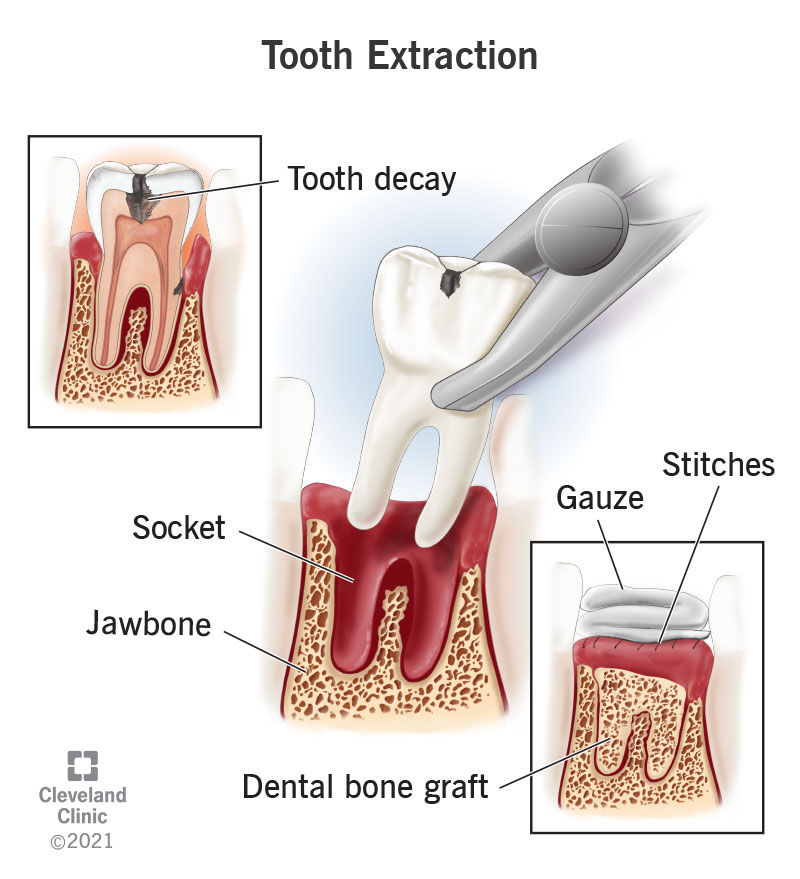A tooth extraction might be necessary if you have dental trauma, damage or decay. Dentists usually recommend extraction when other treatments aren’t enough to save your natural tooth. If you need a tooth pulled, your dentist can discuss replacement options with you.
Advertisement
Cleveland Clinic is a non-profit academic medical center. Advertising on our site helps support our mission. We do not endorse non-Cleveland Clinic products or services. Policy

A tooth extraction is when a dentist removes your tooth from its socket. If you’ve had this oral surgery procedure, you might say you “had a tooth pulled.”
Advertisement
Cleveland Clinic is a non-profit academic medical center. Advertising on our site helps support our mission. We do not endorse non-Cleveland Clinic products or services. Policy
Healthcare providers prefer to save natural teeth whenever possible. But sometimes, restorative methods — like fillings or crowns — aren’t enough. If your tooth has damage past the point of repair, then removal may be necessary. Your dentist may recommend tooth extraction if you have:
Dentists and some dental specialists — like oral and maxillofacial surgeons and periodontists — do tooth extractions. While general dentists do plenty of extractions, more complex cases are usually referred out to specialists.
If you have dental trauma from an accident or injury, you might need an emergency tooth extraction.
Be sure to tell your dentist about any medications, vitamins or supplements you’re taking. They’ll let you know if you need to skip any medications before your surgery.
During a consultation, your dentist will talk with you about the sedation options they offer. Sedation is an excellent choice if you have dental anxiety or if you simply want to be more relaxed and comfortable during your procedure.
Here are the general steps to expect during a tooth extraction:
Advertisement
Removing one tooth usually takes between 30 and 60 minutes. It might take longer if you need multiple teeth extracted.
Tooth extraction reduces harmful bacteria that can damage your teeth and gums. Left untreated, a decayed or damaged tooth can wreak havoc on your smile, causing infection and a host of other problems. Removing your affected tooth gives you the best chance for long-term oral health.
A tooth extraction can also ease dental pain almost immediately, especially if your tooth is severely broken or infected.
Like any surgical procedure, dental extraction carries a small risk of complications, like:
Normal side effects after tooth removal include:
These side effects should go away within a week. Following your dentist’s guidelines can keep you comfortable in the meantime.
Recovery after a tooth extraction depends on several factors, like the size and condition of the affected tooth. But most people feel back to normal in a few days.
You’ll be able to return to routine activities within 48 to 72 hours of a tooth extraction. But it usually takes the jawbone several weeks to heal completely. Most people can return to work or school within a day or two. If you have a job that requires a lot of lifting or physical labor, you may need to take a few more days off work.
If you’re planning on replacing the tooth with a dental implant, you’ll probably need to wait a few months while the socket heals.
An empty tooth socket heals from the bottom, up. Here’s how the process works:
Advertisement
If you’re worried about your progress, here’s a good rule of thumb: A normal socket after tooth extraction will look strange at first. For a large tooth, like a molar, it could take up to four months for your jaw to fully heal. Still, you should call your dentist if you develop signs of infection like fever or drainage from the surgical site.
Below are some things to do — and some things to avoid — after your tooth extraction:
Do:
Don’t:
Advertisement
Your dentist will give you a detailed list of post-surgical instructions. Be sure to ask them if you have specific questions regarding your recovery.
Any time you develop a toothache or dental pain, it’s important to schedule a visit with a dentist. They can help determine the cause and design a personalized treatment plan.
If you’ve already had a tooth extraction, call your dentist if you develop:
It’s never fun hearing that you need to have a tooth pulled. But sometimes, a tooth extraction is the best way to eliminate infection and get you back on track to a healthy smile. If your dentist recommends an extraction, be sure to discuss replacement options with them, too. Dental restorations like dental implants, dental bridges or partial dentures can restore appearance, function and overall oral health.
Advertisement
Dentistry plays an important role in oral health. Cleveland Clinic’s experts can design a personalized plan that will keep you smiling for the long haul.

Last reviewed on 04/04/2025.
Learn more about the Health Library and our editorial process.